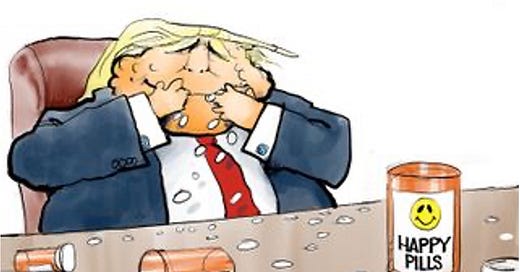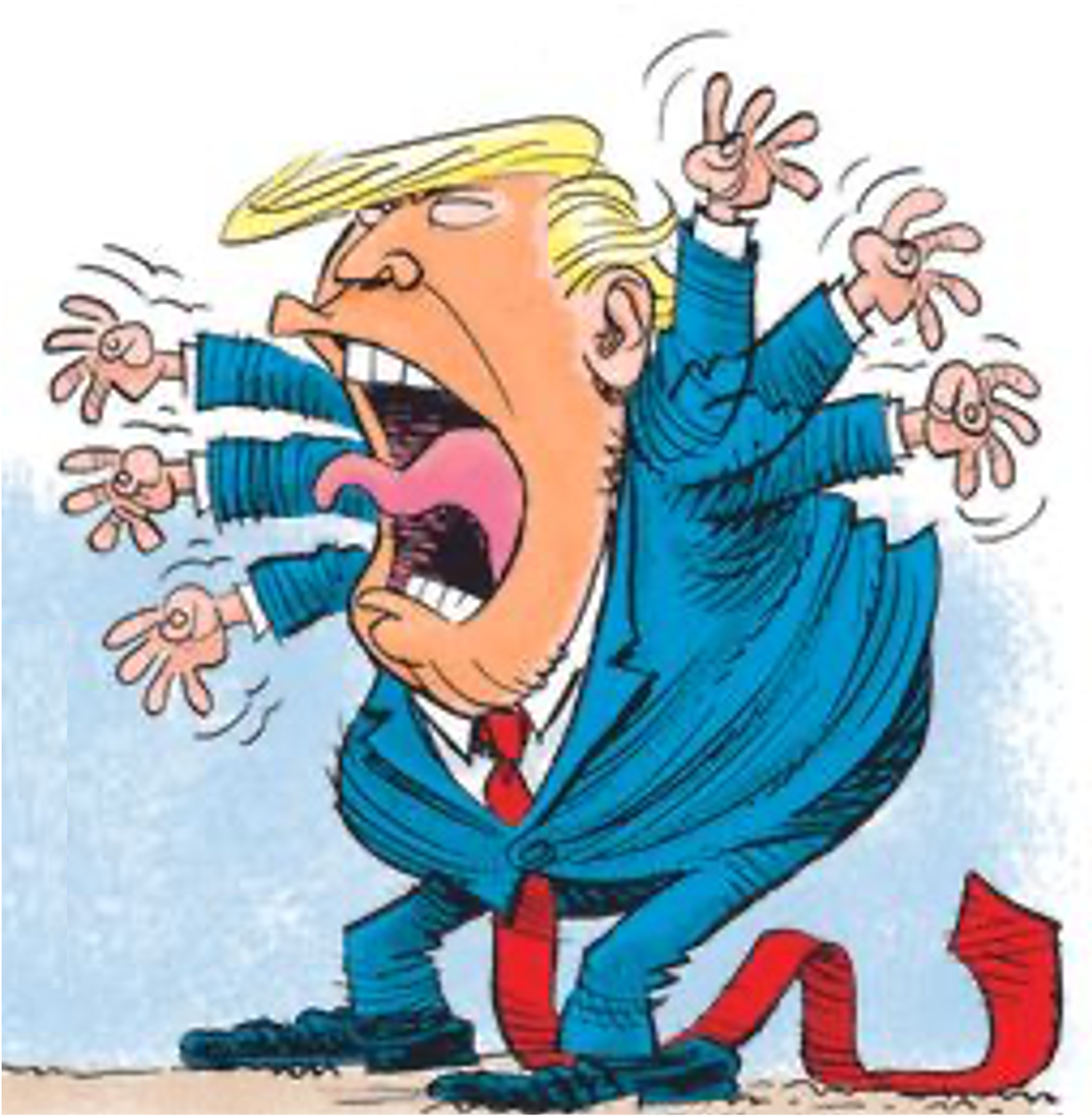Trump’s Drug Use: A Chemically Compromised Commander-in-Chief
How His Reckless Substance Abuse Fuels Paranoia, Impulsivity, and Threatens National Stability
If you enjoy this article, please like, share, subscribe, and tap the Buy Me a Coffee button ☕. Your support keeps me fueled to call out the corrupt and complicit.
As Donald Trump prepares to retake the presidency, a critical question looms: Are we entrusting the country to a man whose erratic behavior is fueled not just by ego but by an alarming combination of dangerous drugs?
For years, firsthand accounts and mounting allegations have painted a disturbing picture of the man poised to reclaim the Oval Office: a leader fueled by a volatile cocktail of drugs, magnifying the paranoia, impulsivity, and impaired judgment that turned his first term into a global spectacle. From Adderall to cocaine, Trump’s likely substance abuse represents far more than a personal failing—it’s a national crisis with global implications.
Dr. Justin Frank, MD, a clinical professor of psychiatry at George Washington University and author of Trump on the Couch, has studied Trump’s psyche with methodical precision. “A leader under the influence of stimulants or sedatives is a threat not just to their own judgment but to the stability of the nation,” warns Dr. Frank. His decades of experience analyzing the psychology of power make his observations impossible to dismiss.
Trump’s first term was defined by chaos; his second may be defined by catastrophe.
A Dangerous Cocktail of Power and Substances
The allegations surrounding Trump’s drug use suggest a mix of stimulants and sedatives, each compounding his most destabilizing traits.
Adderall: Prescribed for ADHD, Adderall sharpens focus. Misused, it fuels aggression, impulsivity, and paranoia. Trump’s manic speeches, compulsive social media habits, and chaotic decision-making align disturbingly well with Adderall misuse.
Cocaine: Known for its bursts of euphoria and exaggerated confidence, cocaine induces paranoia, aggression, and erratic behavior. Trump’s infamous sniffing during debates has long fueled speculation about its use.
Benzodiazepines (Valium/Xanax): These sedatives are often used to counteract stimulant crashes. Their misuse impairs speech, memory, and decision-making, traits evident in Trump’s frequent lapses into incoherence.
Ambien: A sleep aid notorious for causing erratic and bizarre behavior, Ambien could explain Trump’s late-night Twitter rants and disjointed interviews.
Provigil (Modafinil): Designed to promote wakefulness, Provigil can cause paranoia, agitation, and impaired judgment when abused—symptoms familiar in Trump’s behavior.
Together, these substances create a feedback loop: stimulants amplify impulsivity and paranoia, while sedatives dull the ability to self-correct. The result is a leader unmoored from rationality, swinging wildly between manic energy and cognitive fog.
Erratic Behavior Explained
Trump’s public record of paranoid, impulsive, and erratic actions aligns disturbingly well with behaviors associated with stimulant misuse. Numerous firsthand accounts and insider reports further support these claims.
Firsthand Accounts and Witness Reports
Former Apprentice producer Noel Casler, who worked closely with Trump for six seasons, has been particularly vocal about Trump’s probable drug use. Casler described Trump openly snorting crushed Adderall on set, noting the telltale “white powder under his nose.” According to Casler, this dependency was well-known among production staff and directly impacted Trump’s ability to focus, read cue cards, and manage basic responsibilities.
Michael Cohen, Trump’s former lawyer, also calls our Trump’s erratic behaviors in his memoir. Cohen recounts near-daily episodes of paranoia, manic energy, and impulsive decision-making that align with stimulant misuse. Even Mary L. Trump, in her memoir, exposes deeply ingrained psychological fractures—rooted in Trump’s upbringing and personality—that substance abuse would inevitably magnify and dangerously amplify.
Former White House staffers have directly supported these accounts. Stephanie Grisham, Trump’s former press secretary and chief of staff to Melania Trump, described his erratic and volatile late-night behavior in her memoir. John Bolton, Trump’s former national security advisor, characterized him as impulsive and frequently out of control during critical decision-making moments, underscoring his unfitness to lead.
These corroborating accounts lend weight to the assertion that Trump’s behavior is not isolated—it’s consistent, alarming, and reflective of a deeper problem.
Paranoia: Stimulants exacerbate feelings of persecution, feeding Trump’s obsession with imaginary enemies. His fixation on “deep state” conspiracies and personal vendettas against perceived adversaries reflects paranoia run amok.
Impulsivity: Trump’s rapid-fire policy reversals, reckless public statements, and chaotic decision-making undermine stability at every level. These are hallmark behaviors of someone driven by chemically induced impulsivity.
Explosive Anger: Trump’s hostile outbursts and volatile temperament are consistent with the aggression associated with stimulant use. His tirades escalate conflicts, alienate allies, and destabilize governance.
Grandiosity: Trump’s inflated sense of self-importance mirrors the delusions of grandeur often tied to stimulant abuse, leading to reckless overreach and an inability to admit mistakes.
Emotional Volatility: The combination of stimulants and sedatives creates wild mood swings, leaving governance at the whim of Trump’s shifting emotional state.
The Historical Parallel: Drugs and Power
Trump’s probable drug use draws uncomfortable comparisons to Adolf Hitler, whose reliance on stimulants and opioids is extensively documented in Norman Ohler’s Blitzed: Drugs in the Third Reich. Ohler describes how amphetamines fueled Hitler’s manic energy, irrational decision-making, and paranoia, while opioids dulled his crashes, creating a dangerous cycle of chemical dependency.
Dr. Frank highlights the parallel: “The combination of stimulants and sedatives in a leader creates a dangerous feedback loop, driving impulsive decisions and suppressing the ability to self-correct. We’ve seen how this plays out in history—it never ends well.”
Just as Hitler’s chemically altered state contributed to catastrophic decision-making during World War II, Trump’s alleged reliance on substances raises alarms about the potential consequences for a second term. With nuclear weapons and global stability on the line, the stakes couldn’t be higher.
The Dangerous Feedback Loop
Trump’s alleged drug use creates a toxic cycle. Stimulants drive manic energy, paranoia, and impulsive decisions, while sedatives suppress the inevitable crashes, leaving him less capable of introspection or accountability. The result is a leader trapped in a feedback loop that destabilizes governance and endangers national security.
Accountability Before Catastrophe
Donald Trump’s alleged drug use isn’t just a personal weakness—it’s a national emergency. Dr. Justin Frank’s analysis paints a chilling picture of a leader whose paranoia, impulsivity, and cognitive lapses are consistent with stimulant abuse. When placed in the context of history, the dangers become even more pronounced.
Like Hitler during the later years of the Third Reich, Trump’s leadership appears to be influenced by chemical dependency, with all the accompanying risks of paranoia and catastrophic decision-making. The stakes now include global stability, the integrity of democratic institutions, and the survival of a divided nation.
Trump’s first term strained America’s institutions to their breaking point. A second term, fueled by substance abuse, could push them beyond repair.
The question isn’t whether Trump’s behavior is troubling—it is. The question is whether America can afford to ignore the warning signs any longer. A chemically compromised president is not just a liability—it’s a clear and present danger to democracy itself. Accountability must come before catastrophe.
If you enjoyed this article, please like, share, subscribe, and tap the Buy Me a Coffee button ☕. Your support keeps me fueled to call out the corrupt and complicit.
Sources and Readings for This Article: Trump on the Couch (2018) by Dr. Justin Frank, Disloyal: A Memoir (2020) by Michael Cohen, Too Much and Never Enough (2020) by Mary L. Trump, I’ll Take Your Questions Now (2021) by Stephanie Grisham, The Room Where It Happened (2020) by John Bolton, Blitzed: Drugs in the Third Reich (2017) by Norman Ohler, and Rage (2020) by Bob Woodward. Additionally, this article incorporates insights from interviews and public statements by Dr. Justin Frank, Noel Casler, Stephanie Grisham, John Bolton, Michael Cohen, and other former White House insiders, as well as media reports documenting Trump’s behavior and decision-making.





A reader recently messaged me with this pointedly rhetorical question: “So we had the guy with dementia or the drug addict—ain’t democracy great?”
Here's was my reply:
Well, I grant that it was a binary choice (assuming you’re referring to Joe Biden and not the actual Democratic candidate, Kamala Harris). Yes, on the one side, we had a man with declining mental acuity. But on the other side? A likely drug addict, a man with clear signs of his own cognitive decline, and also someone who happens to be:
A serial liar with over 30,000 documented falsehoods during his presidency.
A narcissistic demagogue who demanded constant praise, claimed he deserved a Nobel Peace Prize, and praised dictators like Putin and Kim Jong-un.
A sexual predator, credibly accused by dozens of women and found liable for sexual abuse in court.
A white nationalist apologist who called neo-Nazis “very fine people” and stoked racial division.
A con artist who ran scams like Trump University and grifted $150 million from supporters in a fake “stop the steal” campaign.
A seditionist who incited a violent mob to storm the Capitol, attacking the foundation of American democracy.
A national security threat who hoarded classified documents in his private residence and flaunted them to unqualified individuals.
A vindictive bully who mocked disabled reporters, insulted veterans, and attacked anyone who challenged him.
A tax cheat who bragged about paying nothing while facing decades of financial fraud investigations.
A climate saboteur who gutted over 100 environmental protections and denied the science of climate change.
A COVID-19 disaster whose incompetence and misinformation contributed to the deaths of over a million Americans.
A racist provocateur who sought to ban Muslims, derided African nations as “shithole countries,” and told U.S. citizens to “go back” to their countries of origin.
A grifter-in-chief who funneled taxpayer dollars into his businesses, blatantly violating the Emoluments Clause.
A wannabe autocrat who idolized despots, undermined democratic institutions, and dreamed of unchecked power.
A human foghorn whose divisive rhetoric fractured families, communities, and the nation.
A master manipulator who peddled conspiracy theories and weaponized fear to consolidate power.
A petulant child who threw tantrums over crowd sizes and petty grievances.
A national embarrassment who alienated allies, emboldened enemies, and degraded America’s standing on the world stage.
A man devoid of empathy, whose first reaction to tragedy or loss was, “What about me?”
etc., ad infinitum, ad nauseam. So yes, there was a binary choice: a decent, aging man with some lapses—versus a hurricane of ego, malice, and incompetence who left destruction in his wake. A no-brainer, really.
As an ex-meth user, I can vouch for every single word you said. I know how it fucked me up, I knew it even as I used it. Addiction to stimulants will short circuit your brain and wreck your life. I quit and avoided disaster but know others who did not and the difference in how our lives turned out is staggering. Anyone feeling like I did during those crazy days shouldn't be in charge of feeding a pet, much less being POTUS.